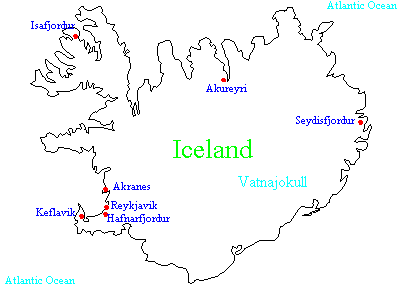 Outline Map of Iceland
Outline Map of Iceland
 and National Flag of Iceland
and National Flag of Iceland
 Outline Map of Iceland
Outline Map of Iceland
 and National Flag of Iceland
and National Flag of Iceland
AD 874 is generally the year that Settlement began by the Viking peoples from Scandinavia. Iceland entered historical times from this date forward because records were made in writing. Such records are found in Íslendingabók (Book of the Icelanders) and Landnámabók (Book of Settlements), though there is disagreement between modern scholars as to whether these are contemparaneous sources.
In 930 the world's first parliament, the Alþing, was set up at Þingvellir (originally this site was called Bláskógar).
By a unique act of law, Icelanders voted to become christians at the Alþing, in AD 1000.
The literary era in which most of the early sagas were written down, occured in 12th century. These works were in two main catagories:
200 years of peaceful coexistence became shattered as family fueds occured. The Norwegian King seized this opportunity to take control of Iceland. In 1262 Icelanders entered into confederacy with Norway, and this early democracy came under a foreign power.
In 1387 the Kalmar Act of Union saw Norway, Sweden and Denmark come under one effective administration by the Danes and this control existed rigth up until the early part of the 20th century.
Foreign domination was a thorn in the Icelander's side and growing disatisfaction became more public. The Alþing was reestablished in 1845 and the struggle for full independence has got its feet firmly planted.
On the millenia anniversary of the Settlement, 1874, a new constitution was given to Iceland by the Danish King Christian IX. The new Alþing had 36 members and only six of these were appointed by the king. This afforded much more independent self- rule by the Icelanders themselves.
In 1918 a new Act of Union was signed and Denmark relinquished all holds but for defense and foreign affairs on Iceland. This Act of Union was to be reviewed again in 1940.
From April 9th 1940, Denmark was under the control of Germany during the Second World War. Due to the incapacity of Denmark to run the defence and foreign affairs of Iceland, the Alþing took over these matters for itself. On May 17th 1941, Icelanders requested total independence. The Republic of Iceland was formally established on June 17th 1944 at Þingvellir.
When Denmark was occupied by Germany, there was a fear that the North Atlantic could come under German influence and so the Americans thought that since Iceland was defenceless, they should have an 'interest' there and created a naval base at Reykjavík's Keflavík airport and the base grew. After the end of the war, the Americans became entrenched and did not want to leave, to the irritation of the local Icelanders. The Americans seemed to be doing the same thing everywhere. For instance, they took over a large part of Okinawa, an island belonging to Japan. The locals there are quite annoyed too...
The infamous Cod Wars came out of Iceland's desire to expand the foreign imposed 4 mile limit for its fishing fleet in 1952. Then to 12, 50, and finally 200 miles in 1958, 1972, and 1975 respectively. Mini sea confrontations between the British Navy and Icelandic Maritime boats happened until 1976, when the two nations signed an agreement. Nowadays the only confrontation is with Greenpeace protestors and the whaling issue.
That concludes the brief history.